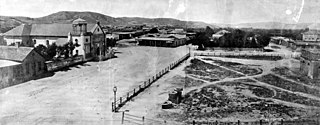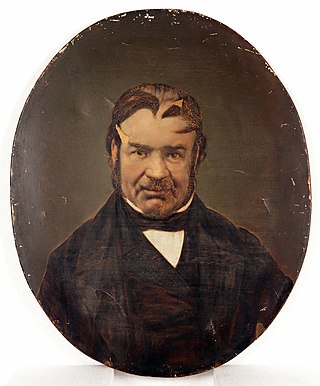
Mission San Gabriel Arcángel is a Californian mission and historic landmark in San Gabriel, California. It was founded by the Spanish Empire on "The Feast of the Birth of Mary," September 8, 1771, as the fourth of what would become twenty-one Spanish missions in California. San Gabriel Arcángel was named after the Archangel Gabriel and often referred to as the "Godmother of the Pueblo of Los Angeles."

Mission San Fernando Rey de España is a Spanish mission in the Mission Hills community of Los Angeles, California. The mission was founded on 8 September 1797 at the site of Achooykomenga, and was the seventeenth of the twenty-one Spanish missions established in Alta California. Named for Saint Ferdinand, the mission is the namesake of the nearby city of San Fernando and the San Fernando Valley.

Mission San Francisco Solano was the 21st, last, and northernmost mission in Alta California. It was named for Saint Francis Solanus. It was the only mission built in Alta California after Mexico gained independence from Spain. The difficulty of its beginning demonstrates the confusion resulting from that change in governance. The California Governor wanted a robust Mexican presence north of the San Francisco Bay to keep the Russians who had established Fort Ross on the Pacific coast from moving further inland. A young Franciscan friar from Mission San Francisco de Asis wanted to move to a location with a better climate and access to a larger number of potential converts.

Hubert Howe Bancroft was an American historian and ethnologist who wrote, published, and collected works concerning the western United States, Texas, California, Alaska, Mexico, Central America, and British Columbia.
Luis Antonio Argüello was the first Californio (native-born) governor of Alta California, and the first to take office under Mexican rule. He was the only governor to serve under the First Mexican Empire and also served as acting governor under the subsequent provisional government, which preceded the First Mexican Republic.
Gabriel Moraga was a Sonoran-born Californio explorer and army officer. He was the son of the expeditionary José Joaquín Moraga who helped to lead the de Anza Expedition to California in 1774. Like his father, Moraga is one of the most notable Spanish expeditionaries in the history of Alta California and the origin of the names of many of the most notable rivers and cities of Northern California and the Central Valley.

The Juan Bautista de Anza National Historic Trail is a 1,210-mile (1,950 km) trail extending from Nogales on the U.S.-Mexico border in Arizona, through the California desert and coastal areas in Southern California and the Central Coast region to San Francisco. The trail commemorates the 1775–1776 land route that Spanish commander Juan Bautista de Anza took from the Sonora y Sinaloa Province of New Spain in Colonial Mexico through to Las Californias Province. The goal of the trip was to establish a mission and presidio on the San Francisco Bay. The trail was an attempt to ease the course of Spanish colonization of California by establishing a major land route north for many to follow. It was used for about five years before being closed by the Quechan (Yuma) Indians in 1781 and kept closed for the next 40 years. It is a National Historic Trail administered by the National Park Service and was also designated a National Millennium Trail.

Joseph Manuel María Joaquin Micheltorena y Llano was a brigadier general and adjutant-general of the Mexican Army, Governor of California, commandant-general and inspector of the department of Las Californias, then within Mexico. Micheltorena was the last non-Californian born Mexican governor, preceding the San Gabriel-born Pío Pico, the last provincial governor.

El Pueblo de Nuestra Señora la Reina de los Ángeles del Río de Porciúncula, shortened to Pueblo de los Ángeles, was the Spanish civilian pueblo settled in 1781, which became the American metropolis of Los Angeles. The pueblo was built using labor from the adjacent village of Yaanga and was totally dependent on local Indigenous labor for its survival.

José Antonio Castro was a Californio politician, statesman, and general who served as interim Governor of Alta California and later Governor of Baja California. During the Bear Flag Revolt and the American Conquest of California, Castro led Mexican forces as the Commandante General of Northern California.
José Antonio Yorba, also known as Don José Antonio Yorba I, was a Spanish soldier and early settler of Spanish California.

The Californias, occasionally known as the Three Californias or the Two Californias, are a region of North America spanning the United States and Mexico, consisting of the U.S. state of California and the Mexican states of Baja California and Baja California Sur. Historically, the term Californias was used to define the vast northwestern region of Spanish America, as the Province of the Californias, and later as a collective term for Alta California and the Baja California Peninsula.
Father Marià Paieres i Borràs (Catalan), commonly known as Mariano Payeras Borrás or Padre Mariano Payeras was a Spanish missionary to the Americas.
José Joaquín de Arrillaga was a Basque officer who served twice as Governor of the Californias and as the first Governor of Alta California, following the partition of the Californias in 1804. He was the only Spanish-era governor to be buried in California.
Ponponio, was the leader of a band of Native American fugitives in California who called themselves Los Insurgentes and who rebelled against Mexican rule and the mission system in California. Under his organization they raided settlements between the areas of modern-day Sonoma and Soledad in the early 19th century.
José María Verdugo was a soldier from the Presidio of San Diego who was assigned to the Mission San Gabriel Arcángel at the time his land was granted by the Spanish Empire in 1784.
Quapa is a former Tongva village located in Encino or the San Fernando Valley in Los Angeles County, California. It was one of several villages located within the San Fernando Valley area, including Kowanga, Mapipinga, Okowvinja, Pascegna, Saway-yanga, Tacuenga, and Tuyunga.
Víctor Pantaleón Linares (1807-1853), Californio, soldier, ranchero, majordomo of Mission San Luis Obispo, vecino and Juez of San Luis Obispo. Grandson of some of the earliest Spanish settlers of California, his second son Pio Linares was an infamous leader,, of a bandit gang in San Luis Obispo County in the 1850s.

Don Antonio María Suñol was a Spanish-born Californio businessman, ranchero, and politician. Suñol served two terms as Alcalde of San José (mayor) and was one of the largest landowners in the Bay Area. He is the namesake of the town of Sunol and the founder of Willow Glen, an affluent neighborhood of San Jose.

The Province of Las Californias was a Spanish Empire province in the northwestern region of New Spain. Its territory consisted of the entire U.S. states of California, Nevada, and Utah, parts of Arizona, Wyoming, and Colorado, and the Mexican states of Baja California and Baja California Sur.










